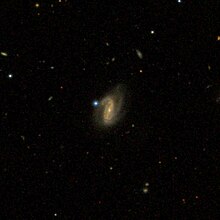
NGC 5364 is a grand design spiral galaxy located 54.5 million light years away in the constellation Virgo. It is inclined to the line of sight from the Earth at an angle of 47° along a position angle of 25°.
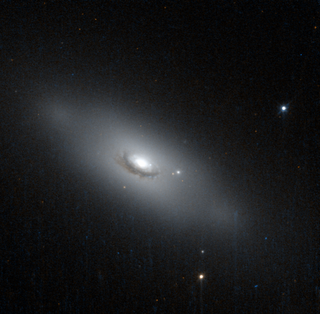
NGC 1260 is a spiral or lenticular galaxy in the constellation Perseus. It was discovered by astronomer Guillaume Bigourdan on October 19, 1884. NGC 1260 is a member of the Perseus Cluster and forms a tight pair with the galaxy PGC 12230. In 2006, it was home to the second brightest supernova in the observable universe, supernova SN 2006gy.

NGC 7020 is a barred lenticular galaxy located about 140 million light-years away in the constellation Pavo. NGC 7020 was discovered by astronomer John Herschel on August 31, 1836.

NGC 3506 is a spiral galaxy in constellation Leo. It is located at a distance of circa 300 million light years from Earth, which, given its apparent dimensions, means that NGC 3506 is about 115,000 light years across. The galaxy has two main spiral arms, with high surface brightness, which can be traced for half a revolution before they fade. One arm splits into four spiral arcs.
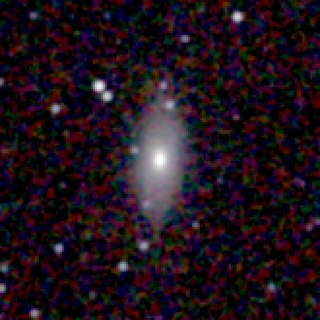
NGC 4743 is a lenticular galaxy located about 145 million light-years away in the constellation Centaurus. NGC 4743 was discovered by astronomer John Herschel on June 8, 1834. It is a member of the Centaurus Cluster.
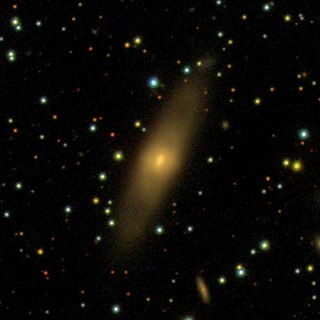
NGC 1250 is an edge-on lenticular galaxy located about 275 million light-years away in the constellation Perseus. It was discovered by astronomer Lewis Swift on Oct 21, 1886. NGC 1250 is a member of the Perseus Cluster.
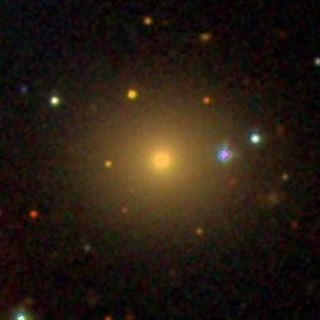
NGC 1259 is a lenticular galaxy located about 243 million light-years away in the constellation Perseus. The galaxy was discovered by astronomer Guillaume Bigourdan on October 21, 1884 and is a member of the Perseus Cluster.

NGC 1264 is a low-surface-brightness barred spiral galaxy located about 145 million light-years away in the constellation Perseus. The galaxy was discovered by astronomer Guillaume Bigourdan on October 19, 1884. NGC 1264 is a member of the Perseus Cluster.

NGC 1267 is an elliptical galaxy located about 220 million light-years away in the constellation Perseus. NGC 1267 was discovered by astronomer Heinrich d'Arrest on February 14, 1863. NGC 1267 is a member of the Perseus Cluster and is possibly interacting with the spiral galaxy NGC 1268.

NGC 1268 is a spiral galaxy located about 140 million light-years away in the constellation Perseus. It was discovered by astronomer Heinrich d'Arrest on February 14, 1863. NGC 1268 is a member of the Perseus Cluster and appears to show signs of distortion in the form of bridges. These features may be the result of a strong interaction with NGC 1267.

NGC 1273 is a lenticular galaxy located about 245 million light-years away in the constellation Perseus. It was discovered by astronomer Heinrich d'Arrest on February 14, 1863 and is a member of the Perseus Cluster.
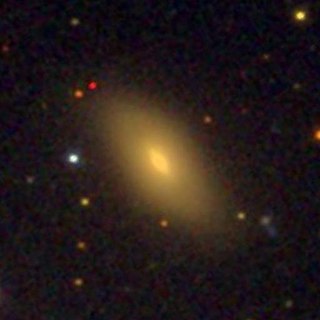
NGC 1274 is a compact elliptical galaxy located about 280 million light-years away in the constellation Perseus. NGC 1274 was discovered by astronomer Lawrence Parsons on December 4, 1875. It is a member of the Perseus Cluster.
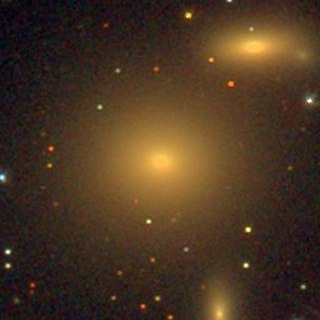
NGC 1278 is an elliptical galaxy located about 230 million light-years away in the constellation Perseus. NGC 1278 was discovered by astronomer Heinrich d'Arrest on February 14, 1863. It was then rediscovered by astronomer Guillaume Bigourdan on October 22, 1884 and was later listed as IC 1907. NGC 1278 is a member of the Perseus Cluster and is a low-luminosity AGN (LLAGN).

NGC 1279 is a lenticular galaxy estimated to be 324 million light-years away from the Milky Way in the constellation Perseus. It has diameter of about 110,000 ly, and is a member of the Perseus Cluster.

NGC 1282 is an elliptical galaxy located about 230 million light-years away in the constellation Perseus. It was discovered by astronomer Guillaume Bigourdan on October 23, 1884. NGC 1282 is a member of the Perseus Cluster.

NGC 1283 is an elliptical galaxy located about 250 million light-years away in the constellation Perseus. The galaxy was discovered by astronomer Guillaume Bigourdan on October 23, 1884 and is a member of the Perseus Cluster. It also contains an active galactic nucleus.

NGC 1293 is an elliptical galaxy located about 215 million light-years away in the constellation Perseus. It was discovered by astronomer William Herschel on October 17, 1786. NGC 1293 is a member of the Perseus Cluster.

NGC 1294 is a lenticular galaxy located about 285 million light-years away in the constellation Perseus. The galaxy was discovered by astronomer William Herschel on October 17, 1786 and is a member of the Perseus Cluster.

NGC 1334 is a spiral galaxy located about 185 million light-years away in the constellation Perseus. It was discovered by astronomer Heinrich d'Arrest on February 14, 1863. NGC 1334 is a member of the Perseus Cluster and is a starburst galaxy. It also appears to have a complex distorted structure.

NGC 4222 is an edge-on spiral galaxy located about 60 million light-years away in the constellation Coma Berenices. It was discovered by astronomer William Herschel on April 8, 1784 and is often misidentified as IC 3087. NGC 4222 is a member of the Virgo Cluster and is a companion of NGC 4216 which lies about 180,000 ly (56 kpc) away. Despite this, the two galaxies are not interacting.
